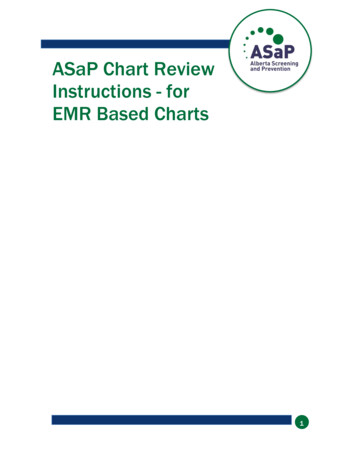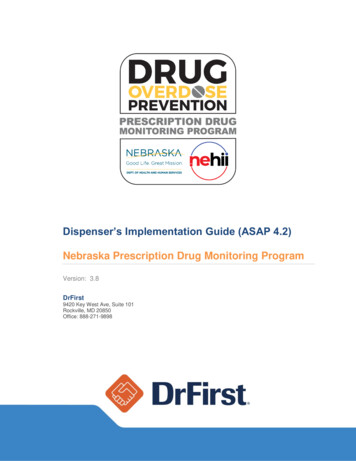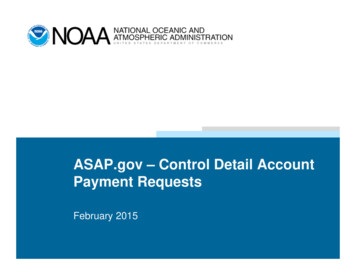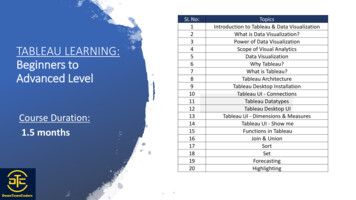
Transcription
ASaP Chart ReviewInstructions - forEMR Based Charts1
Table of ContentsOverview . 3What’s New for 2017 Maneuvers Menu Update . 4Chart Review Preparation . 5One Week (Approx.) Before Baseline Chart Review:. 6One Day before Baseline Chart Review: . 7Day of Baseline Chart Review (At Clinic): . 7Completing the Baseline Chart Review: . 8Baseline Chart Review . 9How to Determine Which Charts to Review. 9Conducting the Chart Review . 10Follow-Up Chart Review (approximately Four Months after Baseline) . 14One Week (Approx.) Before Follow-Up Chart Review: . 15One Day before Follow-Up Chart Review: . 15Day of Follow-Up Chart Review (at Clinic): . 16How to Determine Which Charts to Review. 16Provider Used Both Strategies or Provider Used Outreach Only. 16Provider Used Opportunistic Strategies Only . 20Sustainability Chart Review . 22How to Determine Which Charts to Review. 23Conducting the Chart Review . 24Maneuver Table . 262Updated Dec 2019
OverviewThe purpose of the chart review is to: Provide feedback to providers on their offer of appropriate screens to theirpatients. The baseline chart review will be conducted prior to the start of theredesign period. The follow-up chart review will be conducted when the teamhas adopted changes and is ready to evaluate their progress. Ideally theimprovement process should be completed within 2 months of the baselinechart review and the follow-up chart review at 4 months after the baselinehowever your team may progress at a different rate. TOP will prompt you at 4months after baseline to consider a follow-up chart review. Sustain chartreviews are encouraged (on a yearly basis), beginning 1 year after the followup (optional). Provide information to Primary Care Networks and other primary careorganizations on the impact of the redesign. Provide aggregate information on the effectiveness of the program.Chart reviews are not being conducted for clinical judgment or a research purpose,but rather to provide feedback on improvement efforts and to determine theeffectiveness of the program.3Updated Dec 2019
What’s New for 2017 Maneuvers MenuUpdateWith the release of the Revised Screening Maneuvers Menu for Adults 2017 thereare a few updates to the chart review process. Alcohol Use Assessment has been removed from the Maneuvers Menu. Thismeans that this maneuver is no longer recommended for primary carepractices. New ASaP participants are encouraged to select “No” on the SuperForm setup tab for this maneuver (this is the default selection). Current/existing ASaP participants are not encouraged to continue measuring AlcoholUse Assessment. For current participants an opt-out option is available forthose who decide to stop measuring this maneuver on the Super Form setuptab. Selecting this option will remove the maneuver from the chart review tabin provider’s Super Form ongoing. For those who wish to continue, keepinputting records of offers in the field as normal. Pap screening age of initiation has been increased and NO screening inwomen 18-20 years is emphasized. Pap screening is now recommended tobegin at age 25 (or after commencement of sexual activity whichever is later),not age 21, and women between 21-24 years of age should be given a choice(optional). Additionally, there is a recommendation that providers DO NOT DOscreening for pap on women between the ages of 18 and 20 (inclusive). Assuch, the Super Form will prompt the chart reviewer to examine the record foran offer of screening on women 18 – 20 and 25 – 69. Screening responses of“YES” if NOT offered to the 18 – 20 group will be added to the “YES”screening offered responses for the 25 -69 group to calculate a resultindicating “Pap screening according to recommendations”. Mammography age range has been increased to age 74. The Super Formhas been previously updated to allow chart reviewers to record offers ofscreening mammography up to age 74. Cardiovascular Risk, Plasma Lipid Profile (Non-Fasting) and Diabetesscreening have had their interval ranges increased from 3 years to 5 years.4Updated Dec 2019
When reviewing a chart for offers of screening care for these maneuvers, lookfor evidence of offer in the previous 5 years. Age has been harmonized to 40. Weight has had an interval range increase from annually to every 3 years.When reviewing a chart for offers of screening care for weight, look forevidence of offer in the previous 3 years.Chart Review PreparationThe ASaP Super Form can be downloaded from the ASaP website(actt.albertadoctors.org/PMH/). This one file consists of all the forms related to asingle provider’s improvement journey - i.e., Provider Enrollment Form, ProviderAssessment Form (baseline, follow up), Readiness Assessment Form, Chart ReviewForm (baseline, follow-up and sustain). The remainder of this document will focus onthe Chart Review Forms. Please refer to the ASaP Forms User Guide for moreinformation about the other program forms, how these forms have been built toassist you with this work and for general technical support.When completing a chart review at the provider’s clinic you will need to bring: a laptop with a Windows Operating system and Microsoft Excelo Mac and Open Office are both non-compatible platforms the latest version of the Super Form for the providerIf a laptop is absolutely unavailable, print out a copy of the ASaP Paper Chart ReviewInstructions & Form under the “Tools & Resources” section of the ASaP website(actt.albertadoctors.org/PMH/). You will be responsible for transcribing the papercopies into the electronic ASaP Provider Super Form before submission.Completed chart reviews in Excel must be submitted electronically toasap@albertadoctors.org.IMPORTANTChart reviewers should not consider or rely on any knowledge ofpatient history or clinic processes not documented in the chart.5Updated Dec 2019
Read all instructions before starting.One Week (Approx.) Before Baseline Chart Review:1. Confirm with the Primary Care Network or other organization:a. the direction regarding privacy and confidentiality (e.g., does the PrimaryCare Network have a PIA, do you need to prepare an Affiliate Agreement,etc.).b. that the number of charts to be reviewed (i.e., sample size) has beendetermined. Record this sample size.2. Connect with the Improvement Facilitator:a. to ensure that the provider has selected the maneuvers. Obtain a copy ofthe selection.b. to ensure that the provider is able to generate a panel list (or a portion ofthe panel) and that the panel list contains more than enough charts toconduct the review.For example: if the number of charts to review is 20, ensure thatthe panel list contains 20 or more patients that fit criteriac. to obtain a copy of the Chart Review Forms that has the provider’sinformation already entered.d. to understand any special circumstances in preparation for the chart review.3. Contact the Clinic:a. to schedule a date and time to conduct the chart reviews.b. to ensure that an appropriate person (may or may not be the provider) willbe available to sign the Affiliate Agreement, if needed. The Agreement canbe sent to the clinic ahead of time.6Updated Dec 2019
c. to request that an EMR user account and terminal be available for thedate of the chart reviews. Ideally the clinic would create a user account foryou rather than log you in under an existing account. Ensure you haveadequate permissions within the EMR to view patient records andgenerate a panel list.d. to request that the clinic contact be available to assist you with accessingthe EMR and/or navigating the patient record.e. to confirm the maneuver selection. If there are any changes, confirm thiswith the Improvement Facilitator.f. to confirm, if necessary, that there will be space for you to set up a laptop.4. Be sure you have access to a laptop with Microsoft Office Excel (2007 and newerrecommended) to take with you to the clinic to complete the chart review.One Day before Baseline Chart Review:1. Contact the clinic to confirm the date and time of the chart reviews.2. Confirm access to EMR terminal and login credentials.3. If there will be no internet access at the clinic, generate a random letter by goingto www.randomlettergenerator.com and recording this letter before arrivingonsite.4. Be sure that you have a copy of each provider’s Excel file to complete the chartreview. Book a laptop to bring with you (if necessary).Day of Baseline Chart Review (At Clinic):1. Meet the clinic contact, sign the Oath of Confidentiality, and/or sign the AffiliateAgreement if needed.2. Determine who in the clinic may answer any questions about using the EMR.3. Login to the EMR using your supplied credentials and ask the clinic contact forinstructions and/or a demonstration of how to navigate the patient record.7Updated Dec 2019
4. Ask the clinic contact or EMR support person where you would finddocumentation of screening. You may wish to refer to the specific chart reviewelements in the Maneuver Table section on page 28 of this manual.5. Ask who can assist you with questions should they arise during your chart review.Completing the Baseline Chart Review:The Primary Care Network or other organization determines the number of charts tobe reviewed. This number will be between 10 and 30 in increments of 5. If you arenot sure what the Primary Care Network or other primary care organization hasselected, the chart review form defaults to 20.IMPORTANTAll reviewed charts must meet the following criteria:-Patient age 18 – 79 years old, as of the date of the chart review-Documented attachment to the provider whose review is beingconductedIf patients are paneled to the clinic and not to the provider, the number of charts tobe reviewed remains the same per enrolled provider. That is, the sample size will bemultiplied by the number of enrolled provider’s in the clinic.At any time, refer to the ASaP Forms User Guide for specific technical help on how tocomplete these forms, located on the ASaP website(actt.albertadoctors.org/PMH/). At any time, refer to the ASaP Glossary fordefinition of terms and acronyms located on the ASaP website.8Updated Dec 2019
Baseline Chart ReviewThe baseline chart review is the first review conducted, before the start of theredesign period. This should be completed once the provider has selected whichscreening maneuvers to include and after it has been established that the providercan generate a list of panel patients.How to Determine Which Charts to ReviewGenerate a list of all the patients attached to the provider who are 18 – 79 years old.Sort this list in alphabetical order by last name. The process to do this will differ byEMR. For assistance ask the EMR support person in the clinic how to do this or havehim/her generate the list for you.If you haven’t already done so, go to www.randomlettergenerator.com and record theletter that appears on the screen. In your list of patients, find the first patient recordwhose last name begins with the generated letter, or the next letter with a qualifyingpatient record. This will be the first chart to review.Once the first patient record has been identified, continue to the next patient chart inorder. For last names that appear more than once, use the one that appears first,and skip any others.IMPORTANTFor example, if the letter generated is “J”, the records may look likethis:JacksonJacobsThe chart review will includeJohnson, DJackson, Jacobs, Johnson D,Johnson, Sskip Johnson S, continue withJonesJones and Keith.Keith9Updated Dec 2019
Note: The letter generated is only the start point. There may not beenough patients in that letter to complete the chart review. Workthrough the list in order, continuing to the next letter(s) as needed.We recommend that you identify the complete number of charts to be reviewedbefore to starting the actual record review. This will ensure that you are able tocomplete the chart review.If you are unable to identify the minimum number of charts that fit the inclusioncriteria, contact your Improvement Facilitator and TOP Improvement Advisor. Do notproceed with the chart review.Conducting the Chart ReviewOnce you have identified the patient records that satisfy the number of chartsneeded, you can begin conducting the chart review.In the Excel Chart Review Form you must indicate the maneuvers selected by theprovider on the Set Up tab. You must select Yes or No next to each maneuver. Aminimum of five maneuvers must be selected. Enter the Sample Size (number ofcharts to review) to the right of the table. Click the button “Set Up Complete ActivateBaseline Chart” (indicated below). There will be a prompt asking you to confirm yourchoice. If you click “Ok”, your selections on the Set Up tab will be locked in. This willopen the data entry form for the chart reviews.10Updated Dec 2019
NOTE: Alcohol Use Assessmento defaults “No” as per the 2017 Maneuvers Menu (use the dropdown toselect “Yes” if provider chooses to include)o participants who choose to stop measuring this maneuver can use theopt-out button (doing so will remove it from Super Form chart reviewtabs ongoing) Height and Weight are considered one selection FOBT/FIT, Flex Sig, and Colonoscopy are considered one selectionOpen the patient record and enter the patient gender and age at the top of thescreen for the first patient record (red circle in the picture below).Only maneuvers that are appropriate for that patient will be open for data entry.11Updated Dec 2019
Each maneuver has a unique interval period. This means that you will look back inthe patient chart for different lengths of time depending on the maneuver. The lengthof time is recorded in the Maneuver Table section on page 28, and also on thePreChart tab (indicated by the red arrow).NOTE: If Alcohol Use Assessment appears as a maneuver for measurement; confirmprovider preference for including/excluding this measure.12Updated Dec 2019
IMPORTANTThe ASaP Program measures the offer of a screen regardless if thatscreen was completed or not.Example 1: If a provider documents an offer to do a diabetes screenbut the patient declines, you would record “Yes” for DiabetesScreen.Example 2: If a provider documents that a patient is a non-smokeryou would record “Yes” for Tobacco Use AssessmentIf a patient does not qualify for a maneuver but this has beendocumented in the chart, record “Yes” for the screen.Example 1: A patient meets gender and age requirements for amammogram; However the provider indicates a mammogram doesnot apply because the patient has had a double mastectomy, record“Yes” for screen.The exemption must be recorded in the chart for the screen to be a“Yes”. There is no need to search the entire chart for exemptions.Only search as far back as the maneuver interval. The exemptioncannot be assumed; the provider must clearly indicate that a screenis not required or appropriate.If the provider documents a note to not ask the patient about amaneuver, for any reason, record “Yes” for the screen.In your review of charts it is important that you review all areas of the chart that arenot specific to a patient visit (e.g., the cover sheet of a paper record, complex careplans, the Goals section of the Med Access EMR, etc.).After you have completed the chart reviews, please fill in the fields at the bottom ofthe Chart Review tab, as shown below.13Updated Dec 2019
We are interested in knowing if the training and information you received was helpfulin preparing you to complete this chart review.If possible, record the provider’s estimated panel size.Repeat this process until you have reviewed the number of charts required in yourselection.Repeat this process for each provider enrolled in ASaP.Email completed Excel file(s) to asap@albertadoctors.org.Follow-Up Chart Review (approximately FourMonths after Baseline)The follow-up chart review will be conducted when the team has adopted changesand is ready to evaluate their progress. Ideally the improvement process should becompleted within 2 months of the baseline chart review and the follow-up chartreview at 4 months after the baseline however your team may progress at a differentrate. TOP will prompt you at 4 months after baseline to consider a follow-up chartreview.One week prior to the four month interval date, begin arrangements for the follow-upchart review. This review should be completed and submitted within two weeks ofthat date. In circumstances where the chart review may be longer, consult with theImprovement Facilitator.Repeat the chart review preparation steps:14Updated Dec 2019
One Week (Approx.) Before Follow-Up Chart Review:1. Connect with the Improvement Facilitator:a. to determine the strategies used by the provider during the redesignperiod (see below – How to Determine Which Charts to Review for details).b. to obtain a copy of the Chart Review Forms that has provider’s informationalready entered.c. to understand any special circumstances in preparation for the chart review.2. Contact the Clinic:a. to schedule a date and time to conduct the chart reviews.b. if the provider used outreach strategies, determine if a list can begenerated of those contacted by the outreach strategies. If this list cannotbe generated, connect with your Improvement Facilitator.Confirm that the number of patients reached using outreach strategies isenough to obtain the sample size. If it is not enough, consult with theImprovement Facilitator.c. to request that an EMR user account and terminal be available for thedate of the chart reviews.d. to request that the clinic contact be available to assist you with accessingthe EMR and/or navigating the patient record.e. to confirm, if necessary, that there will be space for you to set up a laptop.One Day before Follow-Up Chart Review:1. Contact the clinic to confirm the date and time of the chart reviews.2. If there will be no internet access at the clinic, go towww.randomlettergenerator.com and record two letters by recording the firstletter on the screen, and the clicking on “Generate another random letter”, andrecord this letter as well.15Updated Dec 2019
Day of Follow-Up Chart Review (at Clinic):1. Ask the clinic contact or EMR support person where you would finddocumentation of screening. You may wish to refer to the specific chart reviewelements in the Maneuver Table on page 28.2. Ask if someone can assist should you have questions during your chart review.How to Determine Which Charts to ReviewBefore conducting the follow-up chart review you must be familiar with how theprovider implemented his/her improvement activities. There are three possiblescenarios: The provider may have used only outreach strategies The provider may have used only opportunistic strategies The provider may have used both outreach and opportunistic strategiesThe process for conducting the follow-up chart review depends on which strategiesthe provider used. The goal of the follow-up chart review is to forecast theimprovement over the entire panel if the provider continued with his/her strategiesover one year by targeting patients using both outreach and opportunistic methods.The follow-up chart review targets patients who do not typically self-present forscreening.In the following sections, two methods are outlined. Refer to the appropriate headingto guide your chart review.Provider Used Both Strategies or Provider Used Outreach OnlyThe first half of the charts to be reviewed will be drawn from patients who hadappointments in the time between the baseline chart review and the follow-up chartreview.Generate a list of patients for the provider whose chart review is being conducted.This list should only contain patients who are aged 18 – 79 and who hadappointments within the past two months prior to today’s date (the date of the follow16Updated Dec 2019
up chart review). This process will differ by EMR. Ask your clinic contact forassistance if needed or get him/her to generate the list for you.IMPORTANTExample: The Baseline Chart Review was completed on May 1st,2013. The Follow-Up Chart Review should be conducted betweenSeptember 1st and September 15th 2013. The generated patient listwill include all patients aged 18 - 79, attached to the provider, whohad appointments between July 1st 2013 and today (the date of theFollow-Up Chart review).Once the list is generated, sort the list in alphabetical order by last name. If you havenot already done so, go to www.randomlettergenerator.com to determine where tostart. Use the first letter that comes up.Find the first patient record whose last name begins with the generated letter. Thiswill be the first chart to review. Continue in order, skipping over any duplicate lastnames until you have identified half of the required number of charts to review. Referto the example on Page 9 for how to select charts.A patient chart should still be reviewed even if the patient came to an appointmentfor another provider, as long as there is confirmation that the patient is attached tothe provider whose review is being conducted.The second half of the charts to be reviewed will be drawn from the list that theprovider used to reach out to patients who do not come in for appointments. Youmust be familiar with how the provider reached out to patients.You must replicate the method used by the clinic.Example 1: The provider uses alphabetized last name to contactpatients, starting with Z. By the time of the follow-up chart review,the staff has made calls through to those whose last names beginwith Th. To determine which charts to review generate a list of all17Updated Dec 2019
charts of patients whose last names begin with Z through to Th, areattached to the provider and who are age 18 – 79 as of today’sdate. Sort the list in alphabetical order, by last name. Use thesecond letter and start with the first patient whose last namematches that letter. Continue in order, skipping over any duplicatelast names until you have identified half of the required number ofcharts to review. Refer to the example on Page 9 for how to selectcharts.Example 2: The provider uses alphabetized last name to contactpatients, starting with K. By the time of the follow-up chart review,the staff has made calls through to those whose last names beginwith P. To determine which charts to review generate a list of allcharts of patients whose last names begin with K through to P, areattached to the provider and who are age 18 – 79 as of today’sdate. Sort the list in alphabetical order, by last name. Use thesecond letter and start with the first patient whose last namematches that letter. If the second letter is before K, then start at thefirst patient under K. If the second letter is after P, then start at thefirst patient under K. Continue in order, skipping over any duplicatelast names until you have identified half of the required number ofcharts to review. Refer to the example on Page 9 for how to selectcharts.Example 3: The provider uses birth month to contact patients,starting with January. By the time of the follow-up chart review thestaff has made calls through to those born in March. To determinewhich charts to review generate a list of all charts of patients bornJanuary – March, who are attached to the provider and who areaged 18 – 79 as of today’s date. Sort the list in alphabetical order by18Updated Dec 2019
last name. Use the second letter generated and find the first patientwhose last name begins with that letter. Review this chart andcontinue in order, skipping over any duplicate last names until youhave identified half of the required number of charts to review. Referto the example on Page 9 for how to select charts.The key is that you must generate your list in the same way the provider generated alist to do outreach. You must generate the same list, in the same order and workthrough the same patients. Once the list is created, apply the same methods asabove for any patient that was contacted.The sample will consist of patients who fit the outreach criteria, regardless ofwhether or not contact was made from the clinic, and regardless of whether or notthey were due for screening. Ensure that list does not exclude individuals who are upto date on screening.Note that if the same chart appears twice, that is, it appears in both the opportunisticsample and in the outreach sample, skip that chart. The same chart should not bereviewed twice. Additionally, if the same last name appears in both samples, skip anyduplicates as in previous samples.Note that if the outreach strategy targeted a subpopulation instead of the wholepanel, the method will be replicated but as applied to the entire panel.Example: The provider produces a list that sorted by last name, andcalls all patients aged 50 and above, starting with “A”. For the chartreview, all patients whose last name begins with the letter “A” will beincluded, regardless of age.19Updated Dec 2019
We recommend that you identify the complete number of charts to be reviewedbefore starting the actual record review. This will ensure that you are able tocomplete the chart review.Note that if an odd sample size is selected (e.g. 15), select the majority of the samplefrom the outreach method.Example: The selected sample size is 15. Eight Charts will be pulledfrom the outreach list.Provider Used Opportunistic Strategies OnlyThe first half of the charts to be reviewed will be drawn from patients who hadappointments in the time between the baseline chart review and the follow-up chartreview.Generate a list of patients for the provider whose chart review is being conducted.This list should only contain patients who are aged 18 – 79 and who hadappointments within the past two months prior to today’s date (the date of the followup chart review). This process will differ by EMR. Ask your clinic contact forassistance if needed or get him/her to generate the list for you.IMPORTANTExample: The Baseline Chart Review was completed on May 1st,2013. The Follow-Up Chart Review should be conducted betweenSeptember 1st and September 15th 2013. The generated patient listwill include all patients aged 18 - 79, attached to the provider, whohad appointments between July 1st 2013 and today (the date of theFollow-Up Chart review).20Updated Dec 2019
Once the list is generated, sort the list in alphabetical order by last name. If you havenot already done so, go to www.randomlettergenerator.com to determine where tostart. Use the first letter that comes up.Find the first patient record whose last name begins with the generated letter. Thiswill be the first chart to review. Continue in order, skipping over any duplicate lastnames until you have identified half of the required number of charts to review. Referto the example on Page 9 for How To Select Charts.A patient chart should still be reviewed even if the patient came to an appointmentfor another provider, as long as there is confirmation that the patient is attached tothe provider whose review is being conducted.The second half of the charts to be reviewed will be drawn from any patient meetingthe inclusion criteria: age 18 – 79, and attachment to the provider whose chartreview is being conducted. This replicates the method used for the baseline chartreview.Generate a list of all the patients attached to the provider in the specified age range(18 – 79). Sort this list in alphabetical order by last name. This process will differ byEMR. Ask your clinic contact for assistance if needed, or get him/her to generate thelist for you.Use the second letter generated. In your list of patients, go to the first patient whoselast name begins with the second letter generated. This will be the first chart toreview. Continue in order, skipping over any duplicate last names until you haveidentified half of the required number of charts to review. Refer to the example onPage 9 for How To Select Charts.We recommend that you identify the complete number of charts to be reviewedbefore starting the actual record review. This will ensure that you are able tocomplete the chart review.Note that if an odd sample size is selected (e.g. 15), select the majority of the samplefrom the outreach method.21Updated Dec 2019
Example: The selected sample size is 15. Eight Charts will be pulledfrom the outreach list, seven charts will be pulled from theopportunistic list.Sustainability Chart ReviewThe sustainability chart review is designed to measure the sustained rate ofdocumented offers of screening care for the entire panel
adequate permissions within the EMR to view patient records and generate a panel list. d. to request that the clinic contact be available to assist you with accessing the EMR and/or navigating the patient record. e. to confirm the maneuver selection. If there are any changes, confirm this with the Improvement Facilitator.











